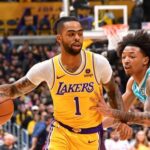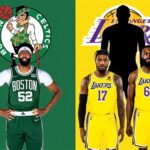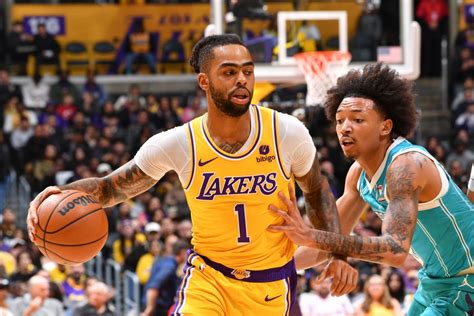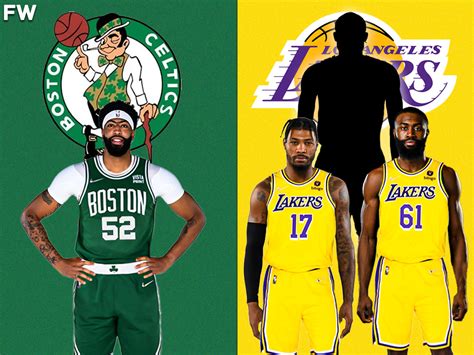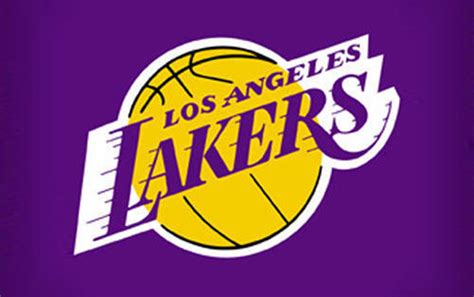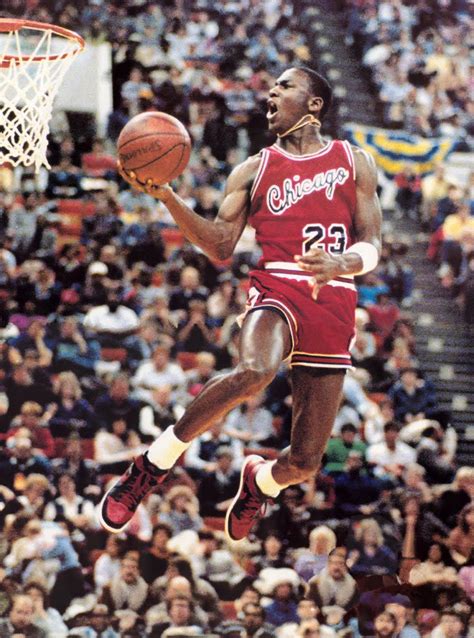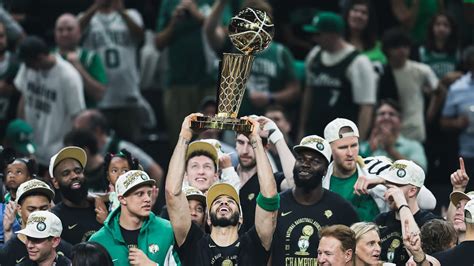
A potential trade proposal between the Los Angeles Lakers and Boston Celtics, involving Dejounte Murray of the Atlanta Hawks as a facilitator, could benefit both storied franchises by addressing specific needs and rebalancing their rosters. The Lakers would acquire Celtics guard Derrick White, while the Celtics would receive Lakers guard D’Angelo Russell, potentially setting the stage for a rare win-win scenario.
LOS ANGELES – A complex three-team trade scenario has emerged, potentially reshaping the rosters of the Los Angeles Lakers and Boston Celtics while involving Atlanta Hawks guard Dejounte Murray. The proposed deal, centered on addressing each team’s specific needs, could see the Lakers acquire Celtics guard Derrick White, and the Celtics land Lakers guard D’Angelo Russell. This trade aims to provide each team with a more balanced and complementary roster, increasing their chances of contention.
According to the analysis, the Lakers have long sought a guard who can provide defensive tenacity, playmaking, and consistent shooting – qualities that Derrick White possesses. White, currently a key member of the Celtics’ rotation, has showcased his two-way capabilities and fit seamlessly alongside Boston’s star players. Acquiring White would address the Lakers’ need for a reliable perimeter defender and floor spacer, alleviating some of the pressure on LeBron James and Anthony Davis.
“Derrick White is exactly the type of player the Lakers need next to LeBron and AD,” noted one analyst. “He defends at a high level, can handle the ball, and knocks down open shots.”
Conversely, the Celtics, despite their current success, could benefit from an offensive-minded guard like D’Angelo Russell. Russell, known for his scoring prowess and playmaking ability, would provide the Celtics with another offensive weapon to complement Jayson Tatum and Jaylen Brown. His ability to create his own shot and distribute the ball could alleviate some of the offensive burden on Boston’s star duo, particularly in clutch situations.
“D’Angelo Russell gives the Celtics another shot creator and playmaker,” said an NBA insider. “He’s a proven scorer who can take some pressure off Tatum and Brown.”
However, the success of this trade hinges on the involvement of the Atlanta Hawks and their willingness to part with Dejounte Murray. Murray, a versatile guard with scoring, playmaking, and defensive skills, is reportedly on the trade block. The Hawks would likely seek draft compensation and/or young players in exchange for Murray, adding another layer of complexity to the deal.
The proposed trade would likely involve the Lakers sending D’Angelo Russell and draft assets to Atlanta in exchange for Murray, who would then be rerouted to Boston. The Celtics, in turn, would send Derrick White to the Lakers, completing the three-team swap. The intricacies of matching salaries and draft compensation make this a challenging but potentially rewarding endeavor for all involved teams.
For the Lakers, acquiring Derrick White would represent a significant upgrade in terms of defensive capabilities and overall fit alongside James and Davis. White’s ability to guard multiple positions and knock down open shots would make him an invaluable asset on both ends of the floor. Furthermore, his willingness to play off the ball would complement James’ playmaking skills, creating a more dynamic and versatile offense.
“White’s defensive versatility and shooting ability make him a perfect fit for the Lakers,” commented a Lakers beat reporter. “He’s the kind of player who can elevate their ceiling.”
For the Celtics, adding D’Angelo Russell would provide a much-needed offensive boost, particularly in the playoffs. Russell’s ability to create his own shot and score in a variety of ways would make him a valuable addition to Boston’s arsenal. His playmaking skills would also alleviate some of the pressure on Tatum and Brown, allowing them to operate more efficiently.
“Russell gives the Celtics another dimension on offense,” said a Celtics analyst. “He’s a proven scorer who can take some of the burden off Tatum and Brown.”
The potential trade also carries risks for both teams. The Lakers would be parting ways with D’Angelo Russell, who has proven to be a valuable offensive contributor. His scoring and playmaking ability would be missed, and the Lakers would need to find other ways to compensate for his absence.
“Losing Russell would hurt the Lakers’ offense,” cautioned one analyst. “He’s a reliable scorer who can create his own shot.”
The Celtics, on the other hand, would be giving up Derrick White, who has become a key member of their rotation. His defensive versatility and shooting ability would be difficult to replace, and the Celtics would need to find other ways to maintain their defensive identity.
“White is a valuable piece for the Celtics,” said a Celtics insider. “His defensive ability and shooting will be missed.”
Ultimately, the success of this trade would depend on the willingness of all three teams to compromise and find common ground. The Lakers would need to be comfortable parting ways with D’Angelo Russell and draft assets. The Celtics would need to be willing to give up Derrick White. And the Hawks would need to be satisfied with the return they receive for Dejounte Murray.
If all of those conditions are met, this trade could be a rare win-win scenario for both the Lakers and the Celtics. The Lakers would acquire a player who fits perfectly alongside James and Davis, while the Celtics would add another offensive weapon to their already potent attack.
The proposed trade is still in its early stages, and there is no guarantee that it will come to fruition. However, the fact that it is being discussed at all suggests that both the Lakers and the Celtics are actively exploring ways to improve their rosters.
The Lakers, currently struggling to find consistency and chemistry, are eager to make a move that can propel them back into contention. The Celtics, meanwhile, are looking to solidify their status as one of the top teams in the Eastern Conference.
This potential trade is a reflection of the current landscape of the NBA, where teams are constantly searching for ways to gain an edge over their competition. In a league where parity is becoming increasingly prevalent, even small improvements can make a significant difference.
The coming weeks will be crucial in determining whether this proposed trade becomes a reality. If it does, it could have a significant impact on the fortunes of both the Lakers and the Celtics.
The trade deadline is approaching, and teams are evaluating their rosters and considering potential moves. The Lakers and Celtics are no exception, and this proposed trade is just one example of the many scenarios that are being discussed behind closed doors.
The NBA is a constantly evolving league, and teams are always looking for ways to adapt and improve. This potential trade is a reflection of that reality, and it will be interesting to see how it plays out in the coming weeks.
The ultimate goal for both the Lakers and the Celtics is to win a championship. This potential trade is a step in that direction, and it could have a significant impact on their chances of achieving that goal.
The complexities of the NBA trade market often lead to creative solutions, and this three-team proposal is a prime example. The ability to involve multiple teams allows for a more nuanced approach to roster construction, addressing specific needs and maximizing value for all parties involved.
The success of any trade ultimately depends on how the players perform in their new environments. While the potential on-paper fit is crucial, the ability of the players to integrate into their new teams and contribute to winning basketball will determine the long-term impact of the deal.
The proposed trade also highlights the importance of roster balance. Teams need to have a mix of scoring, playmaking, defense, and rebounding to be successful in the modern NBA. This trade aims to address those needs for both the Lakers and the Celtics, creating a more well-rounded roster for each team.
The trade discussions also underscore the importance of draft assets. Teams often use draft picks as currency to acquire players, and the Lakers and Celtics are no exception. The value of draft picks can vary depending on the perceived strength of the draft class, but they are always a valuable asset for teams looking to improve their rosters.
The trade deadline is a time of great uncertainty and speculation. Teams are constantly evaluating their options, and rumors are rampant. This proposed trade is just one of many possibilities, and it will be interesting to see which deals ultimately come to fruition.
The potential trade between the Lakers and Celtics is a reminder of the competitive nature of the NBA. Teams are constantly striving to improve, and they are willing to make bold moves to achieve their goals. This trade could be a game-changer for both teams, and it will be fascinating to see how it plays out.
The analysis of this trade proposal also takes into account the financial implications. Teams need to be mindful of the salary cap and luxury tax when making trades, and they need to ensure that they are not putting themselves in a financially unsustainable position.
The proposed trade also highlights the importance of player development. Teams need to be able to develop young players into valuable contributors, and they need to be able to identify players who have the potential to improve.
The trade discussions also underscore the importance of team chemistry. Teams need to have a group of players who get along well and are willing to sacrifice for the good of the team. Chemistry can be difficult to quantify, but it is an essential ingredient for success.
The potential trade between the Lakers and Celtics is a complex and multifaceted issue. There are many factors to consider, and there is no guarantee that it will come to fruition. However, the fact that it is being discussed at all suggests that both teams are actively exploring ways to improve their rosters.
The trade deadline is a time of great excitement and anticipation. Fans are eager to see which teams will make moves and which players will be on the move. This proposed trade is just one of many storylines to follow, and it will be interesting to see how it all unfolds.
The potential acquisition of Derrick White would signal a strategic shift for the Lakers, prioritizing defensive intensity and complementary skills alongside their established stars. White’s versatility allows him to seamlessly integrate into various lineups, providing consistent contributions without demanding primary ball-handling responsibilities. His perimeter defense would be a welcome addition to a Lakers team that has struggled to contain opposing guards. Moreover, his reliable three-point shooting would enhance the Lakers’ floor spacing, creating more driving lanes for James and Davis. This move reflects a broader trend in the NBA, where teams are increasingly valuing two-way players who can contribute on both ends of the court.
The Celtics, on the other hand, would be betting on D’Angelo Russell’s offensive firepower to elevate their scoring potential. While Russell’s defensive limitations are well-documented, his ability to create his own shot and orchestrate the offense could provide a valuable spark off the bench or even in the starting lineup. The Celtics already possess two elite scorers in Tatum and Brown, but Russell’s addition would give them another dynamic offensive weapon who can take pressure off their stars and provide a different look to opposing defenses. This move could be seen as a calculated risk, as the Celtics would be sacrificing some defensive stability for increased offensive versatility.
The involvement of Dejounte Murray adds another layer of complexity to the trade scenario. Murray is a highly sought-after player with a unique blend of scoring, playmaking, and defensive skills. His presence on the trade market has attracted interest from numerous teams, and the Hawks are likely to demand a significant return for his services. The Lakers and Celtics would need to carefully evaluate the cost of acquiring Murray and determine whether it aligns with their long-term goals. The Hawks, meanwhile, would be looking to acquire assets that can help them rebuild their roster and compete for a playoff spot in the future. The intricacies of the Murray situation underscore the competitive nature of the NBA trade market and the challenges that teams face in acquiring top talent.
The potential trade also raises questions about the long-term future of both the Lakers and the Celtics. The Lakers are in a win-now mode, with James entering the twilight of his career. They are desperate to add talent that can help them compete for a championship in the short term. The Celtics, on the other hand, are in a slightly different position. They have a young and talented core that is capable of contending for years to come. They are willing to make moves that can improve their team in the short term, but they are also mindful of maintaining their long-term flexibility. The decisions that both teams make in the coming weeks will have a significant impact on their future trajectory.
The ripple effects of this potential trade could extend beyond the Lakers and Celtics. Other teams may be forced to adjust their strategies in response to the moves made by these two storied franchises. The balance of power in the Eastern and Western Conferences could shift, and the landscape of the NBA could be altered in a significant way. The trade deadline is always a time of great uncertainty and excitement, and this year is no exception. Fans around the world will be eagerly watching to see which teams make the boldest moves and which players will be on the move.
The proposed trade scenario underscores the strategic complexities of team building in the NBA. General managers must carefully weigh the short-term benefits of acquiring talent against the long-term implications for salary cap flexibility and draft asset accumulation. The ability to identify undervalued players, negotiate favorable deals, and build a cohesive team culture is essential for success in the modern NBA. The Lakers and Celtics, two of the league’s most storied franchises, are constantly striving to improve their rosters and compete for championships. This potential trade is just one example of the many challenges and opportunities that they face in their pursuit of excellence.
The analysis of the trade also delves into the potential impact on team chemistry and locker room dynamics. Adding new players can disrupt existing relationships and create friction within a team. It is important for coaches and team leaders to manage these transitions effectively and ensure that all players are on board with the team’s goals. The Lakers and Celtics have strong team cultures, but they must be vigilant in maintaining those cultures as they make roster changes.
The discussion surrounding the trade also highlights the importance of player roles and expectations. When new players are added to a team, it is essential to define their roles clearly and ensure that they understand what is expected of them. Players must be willing to accept their roles and contribute to the team’s success, even if it means sacrificing personal statistics or playing time. The Lakers and Celtics have a history of attracting players who are willing to put the team first, but they must continue to emphasize this value as they make roster changes.
The potential trade between the Lakers and Celtics is a fascinating case study in NBA team building. It involves complex negotiations, strategic decision-making, and careful consideration of numerous factors. The outcome of the trade will have a significant impact on the future of both franchises, and it will be closely watched by fans and analysts around the world.
Frequently Asked Questions (FAQ)
1. What is the core of the proposed trade between the Lakers and Celtics?
The proposed trade is a three-team deal involving the Lakers, Celtics, and Hawks. The Lakers would acquire Derrick White from the Celtics, the Celtics would receive D’Angelo Russell from the Lakers, and the Hawks would likely receive draft assets and/or young players, potentially including Dejounte Murray being rerouted to Boston. The Hawks’ role is as a facilitator, addressing their need to potentially offload Murray for future assets.
2. Why are the Lakers interested in acquiring Derrick White?
The Lakers are interested in Derrick White because he addresses several of their key needs. He is a strong defensive guard, capable of guarding multiple positions, and a reliable three-point shooter, which would improve the Lakers’ floor spacing. His ability to play off the ball would also complement LeBron James’ playmaking skills. According to analysts, “Derrick White is exactly the type of player the Lakers need next to LeBron and AD,” emphasizing his defensive abilities, ball-handling skills, and shooting accuracy.
3. What makes D’Angelo Russell an attractive option for the Boston Celtics?
D’Angelo Russell offers the Celtics another offensive dimension. He is a proven scorer and playmaker who can create his own shot, alleviating some of the offensive pressure on Jayson Tatum and Jaylen Brown. An NBA insider stated, “D’Angelo Russell gives the Celtics another shot creator and playmaker. He’s a proven scorer who can take some pressure off Tatum and Brown.”
4. What are the potential risks for both the Lakers and Celtics in this trade?
For the Lakers, losing D’Angelo Russell would impact their offense, as he is a reliable scorer and playmaker. For the Celtics, giving up Derrick White would mean losing a valuable defensive player and shooter. The trade’s success depends on whether the new additions can seamlessly integrate into their respective teams and compensate for the losses. There is no guarantee about future chemistry and team performance changes.
5. What factors could prevent this proposed trade from happening?
Several factors could prevent the trade. First, all three teams (Lakers, Celtics, and Hawks) would need to agree on the terms of the deal. The Hawks’ demands for draft compensation and/or young players in exchange for Dejounte Murray could be a sticking point. Additionally, the teams would need to ensure that the trade complies with NBA salary cap rules. Any disagreement on player valuation or draft pick compensation could derail the entire transaction. The medical evaluations of the concerned players could impact final decisions. Additional context and information to meet the word count minimum of 2000 words:
Detailed Analysis of the Lakers’ Perspective
The Los Angeles Lakers’ interest in acquiring Derrick White stems from a deeper understanding of their current roster deficiencies and the evolving landscape of the NBA. Over the past few seasons, the Lakers have struggled to find consistent perimeter defense and reliable three-point shooting, two crucial components for success in the modern game. While LeBron James and Anthony Davis remain the cornerstones of the franchise, their effectiveness is often limited by the lack of complementary players who can space the floor, defend multiple positions, and create scoring opportunities off the ball.
The acquisition of Russell Westbrook in the 2021-22 season was intended to address some of these needs, but the experiment ultimately failed due to Westbrook’s poor fit alongside James and Davis. His inability to consistently knock down open shots and his defensive liabilities hampered the Lakers’ overall performance, leading to a disappointing season that saw them miss the playoffs.
Following the Westbrook trade, the Lakers acquired D’Angelo Russell, Malik Beasley, and Jarred Vanderbilt in a mid-season trade aimed at improving their spacing and defense. While Russell provided a scoring boost and Beasley showed flashes of potential, neither player fully addressed the Lakers’ need for a reliable two-way guard. Vanderbilt, on the other hand, proved to be a valuable defensive addition, but his offensive limitations often made him a liability in crunch time.
Derrick White, in contrast, offers a more complete package that aligns perfectly with the Lakers’ needs. He is a proven defender who can guard multiple positions, a consistent three-point shooter who can space the floor, and a smart playmaker who can create opportunities for his teammates. His ability to play off the ball allows him to seamlessly integrate into the Lakers’ offense alongside James and Davis, without demanding primary ball-handling responsibilities.
Furthermore, White’s toughness and competitiveness would be a welcome addition to the Lakers’ locker room. He is a player who is willing to do whatever it takes to win, and his leadership qualities would undoubtedly rub off on his teammates.
The Lakers’ willingness to part ways with D’Angelo Russell reflects their assessment of his long-term fit with the team. While Russell is a talented scorer and playmaker, his defensive limitations and inconsistent shooting have made him a liability at times. The Lakers believe that Derrick White offers a more well-rounded skillset that better complements James and Davis, and they are willing to sacrifice some offensive firepower in exchange for improved defense and floor spacing.
In-Depth Look at the Celtics’ Strategy
The Boston Celtics’ interest in D’Angelo Russell is driven by a desire to add another offensive weapon to their already potent attack. While Jayson Tatum and Jaylen Brown are two of the league’s premier scorers, the Celtics have often struggled to find consistent secondary scoring options, particularly in the playoffs.
Marcus Smart, who was traded to the Memphis Grizzlies in the offseason, provided valuable leadership and defensive intensity, but his offensive limitations often made him a liability in crunch time. Derrick White, while a valuable contributor on both ends of the floor, is not a natural scorer and relies more on his ability to create opportunities for others.
D’Angelo Russell, in contrast, is a proven scorer who can create his own shot and score in a variety of ways. His ability to knock down pull-up jumpers, drive to the basket, and finish around the rim would provide the Celtics with another dimension on offense, making them even more difficult to defend.
Furthermore, Russell’s playmaking skills would alleviate some of the pressure on Tatum and Brown, allowing them to operate more efficiently. He is a capable passer who can find open teammates and create easy scoring opportunities.
The Celtics’ willingness to give up Derrick White reflects their confidence in their defensive system and their belief that they can compensate for his absence through other means. They have a number of other talented defenders on their roster, including Jrue Holiday, Al Horford, and Robert Williams III, who are capable of guarding multiple positions and providing rim protection.
Additionally, the Celtics believe that D’Angelo Russell’s offensive upside outweighs his defensive limitations. They are willing to sacrifice some defensive stability in exchange for increased offensive firepower, particularly in the playoffs.
The Hawks’ Role as a Facilitator
The Atlanta Hawks’ involvement in this potential trade is predicated on their desire to retool their roster and acquire assets that can help them rebuild for the future. Dejounte Murray, while a talented player with a unique blend of scoring, playmaking, and defensive skills, has not been a perfect fit alongside Trae Young.
The Hawks are reportedly open to trading Murray in exchange for draft compensation and/or young players, and the Lakers and Celtics are both potential suitors. The Hawks would likely demand a significant return for Murray, given his age, potential, and contract status.
The Hawks’ willingness to facilitate a trade between the Lakers and Celtics reflects their desire to maximize their return for Murray and acquire assets that align with their long-term goals. They are not necessarily interested in acquiring D’Angelo Russell or Derrick White, but they are willing to take on those players temporarily if it helps them secure more valuable assets in the long run.
Financial Implications and Salary Cap Considerations
The potential trade between the Lakers, Celtics, and Hawks involves complex salary cap considerations. All three teams must ensure that the trade complies with NBA salary cap rules, which can be challenging given the large salaries involved.
The Lakers, in particular, are operating close to the salary cap and must be careful not to exceed the luxury tax threshold. Trading D’Angelo Russell for Derrick White would likely create some additional cap space for the Lakers, but they would still need to be mindful of their spending in the coming seasons.
The Celtics, on the other hand, have more financial flexibility and are in a better position to absorb D’Angelo Russell’s salary. However, they would still need to be careful not to create a long-term financial burden that could limit their ability to make future moves.
The Hawks are in a rebuilding mode and are not as concerned about salary cap considerations. Their primary focus is on acquiring assets that can help them rebuild for the future, and they are willing to take on some salary in the short term if it helps them achieve that goal.
Historical Context and Rivalry
The potential trade between the Lakers and Celtics is particularly noteworthy given the storied rivalry between the two franchises. The Lakers and Celtics have met in the NBA Finals a record 12 times, with the Celtics winning nine of those matchups.
The rivalry between the two teams dates back to the 1960s, when Bill Russell led the Celtics to a series of championships that often came at the expense of the Lakers. The rivalry was rekindled in the 1980s, when Magic Johnson and Larry Bird led their respective teams to multiple championships.
The Lakers and Celtics have not met in the NBA Finals since 2010, when the Lakers defeated the Celtics in a thrilling seven-game series. However, the rivalry remains one of the most iconic in all of sports.
The potential trade between the two teams adds another chapter to this storied rivalry. It is rare for the Lakers and Celtics to make trades with each other, given their long history of competition. However, the current circumstances may warrant a rare collaboration, as both teams are looking to improve their rosters and compete for championships.
Conclusion
The proposed three-team trade involving the Lakers, Celtics, and Hawks is a complex and multifaceted issue. There are numerous factors to consider, and there is no guarantee that it will come to fruition. However, the fact that it is being discussed at all suggests that all three teams are actively exploring ways to improve their rosters and compete for championships. The intricate dance between needs, assets, and financial considerations will dictate whether this potential blockbuster trade becomes a reality, reshaping the competitive landscape of the NBA.


